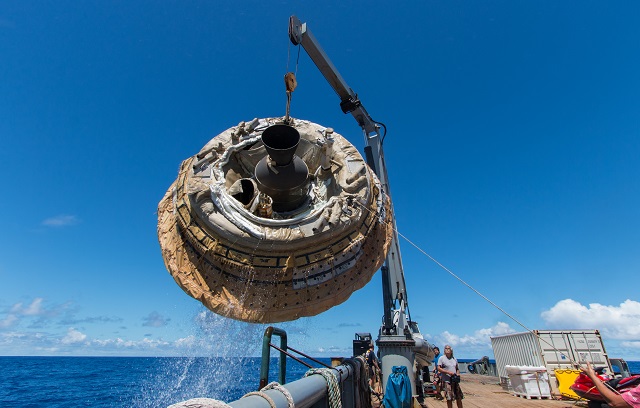
Hours after the June 28, 2014, test of NASA's Low-Density Supersonic Decelerator over the U.S. Navy's Pacific Missile Range, the saucer shaped test vehicle is lifted aboard the Kahana recovery vessel. Image Credit: NASA/JPL-Caltech
NASA's saucer-shaped test vehicle was successfully launched into Earth’s atmosphere as part of their Low-Density Supersonic Decelerator (LDSD) mission in June 2014. The flight test was conducted at the Pacific Missile Range Facility of the US Navy located in Kauai, Hawaii.
The flight test was the first of the three vehicles destined for the LDSD mission funded by the Space Technology Mission Directorate of NASA. The objective of the test was to determine the ability of the rocket-powered, balloon-launched vehicle to achieve the airspeeds and altitudes required for the testing of two new technologies designed for future Mars missions.
The test vehicle carried the two advanced technologies as payload during the flight.
One is the Supersonic Inflatable Aerodynamic Decelerator (SIAD), a doughnut-shaped air brake that was applied during the flight to reduce the vehicle speed from 3.8 to 2 times the speed of sound.
The other one is the Supersonic Disksail Parachute, which has an area more than two times of the parachute used in NASA’s Mars Science Laboratory (MSL) project.
Testing of these breakthrough technologies is scheduled for 2015 aboard a similar type of test vehicle.
LDSD: Supersonic Test Flight (HD)
Video sourced from YouTube - NASA Jet Propulsion Laboratory
The 7,000-pound saucer also carried several high-definition video cameras. The arresting imagery helps in understanding the flight dynamics of the test vehicle better at high Mach numbers and altitudes.
Cutting-edge technologies were tested under the LDSD cross-cutting demonstration mission which will hopefully enable the safe landing of large payloads on the Martian surface whilst also allowing more areas of the planet to be accessed by facilitating landings at higher altitude sites.
Mark Adler, project manager for LDSD at NASA's Jet Propulsion Laboratory declared the team were "thrilled" with the results of the test, stating that the vehicle had performed very well and all pre-flight targets were completed succesfully.
He then went on to say that the data collected could help a great deal with future flights of this kind.
Mission to Mars
Whilst human missions to Mars are not yet plausible, NASA are continually taking several large steps towards making this possible in the future.
With their recent testing of the 'Cannae Drive' thruster, announcing that they have proposed a series of improved energy storage devices and their dedicated Mars Group working at the Niels Bohr Institute, missions to Mars may well be achieved by 2020.